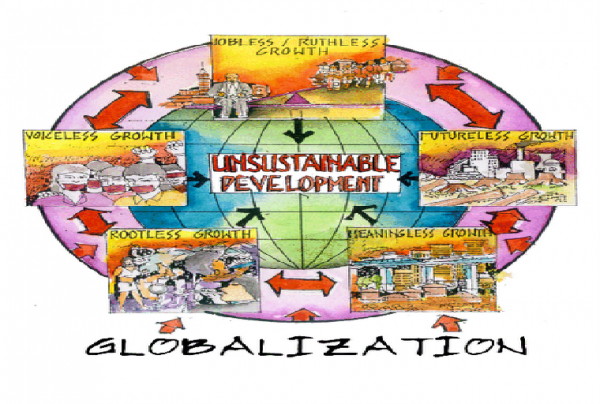GLOBALISATION AND ITS IMPACT ON INDIAN SOCIETY

Globalisation has emerged as one of the most frequently used term of which there is no universally acceptable definition. World¬wide opinions are divided both in support and opposition of it. Globalisation is derived from the term “global” which implies covering the globe.
Thus, globalisation means something which covers or relates the whole world instead of being confined to a particular country. With the development of modern science and technology, whole world has been closely united as a global village. What happens in one country has its impact on others.
We are using the term internationalism as a political process. This process highlights increasing political, social, economic and cultural relations among various nations of the world. Now globalisation is advocated as a process aimed at integrating the whole world system. It implies the integration of a nation’s economy with the world economic system.
Globalisation means different things to different people. Economists consider it as a step towards a fully integrated world market. Some political scientists view it as a march away from the conventionally defined concept of the state.
The sovereignty of the state is challenged with the emergence of non-governmental power players in the world order. Globalisation is not an event, rather a process which originated with the liberalisation and privatisation of the economic sectors. It aims for the establishment of a borderless world.
Background:
Nations having socialistic economic system and mixed economy failed to achieve targeted economic growth. In 1980s, public sectors faced loss due to bureaucratic inefficiency, red-tapism, political interference, corruption and irresponsibility of the managing authority. Where there is ‘monopoly’ there is inefficiency due to lack of competition.
Public sectors thus, failed to produce profitable results and created massive financial loss. There was price rise, capital crunch, lack of technical know-how and slow pace in economic growth. The situation demanded Soviet Russia to initiate economic reforms through “Perestroika”. More or less, India faced the same situation. To overcome the situation, P.V. Narsingh Rao government adopted the new economic policy of liberalisation and privatisement.
Before 1970s, industrially develop western countries faced economic crisis. Economic depression lowered down the profit of big industries. Instead of depending on their own market, the entrepreneurs wanted to expand their business in other countries of the world. While these western companies were in search of market in different parts of the world, socialistic states wanted them in the privatisation process of public sectors.
Undeveloped third world countries also realized the need of foreign capital and technical knowhow for their economic growth. The process of economic liberalisation began as a precondition of globalisation. Thus, capital, technical knowledge, labour, profit, managerial skill etc. move from one nation to another cutting across the territorial limitation with the primary goal of expanding trade and business.
Globalisation, as a negative process, stands for the abolition of protective economic policies which were previously adopted in the national interest. Governments had created trade barriers by increasing the rate of tariff and through the imposition of restrictions on import of foreign goods. Globalisation stands for the elimination of such negative barriers for the free flow of goods and capital.
Positively speaking, globalisation encourages free world trade, free enterprise and market forces. It advocates for the process of integrating the domestic economy with the world economy through increased collaborations among the entrepreneurs. In this process, they can have access to more capital flows, technical knowhow, cheaper imports and larger export markets.
Globalisation in India:
India became independent as one of the poorest countries of the world. The British colonial rule had destroyed the self-sufficient agrarian economy. Prime Minister Jawaharlal Nehru preferred mixed economy for planned economic development of the country. Public sectors were set up along with a number of private enterprises. But like the socialistic model of economy, the mixed economy of India has not produced profitable results.
A number of public sectors became sick and the growth rates of production had begun to fall. The government was compelled to sanction subsidy to make the price of some essential commodities low, despite the rising burden on state exchequer. While the poverty of the people continued to grow to an alarming extent, there was an acute balance of payment crisis. Due to low domestic savings, there was no adequate capital for investment.
There was also shortage of resources to provide educational and health facilities to a large growing population. Moreover, there was high rate of inflation and the balance of payment deficit was around $10 bn. In such a situation P.V. Narsingh Rao government was compelled to introduce the policy of liberalisation and privatisation. Dr. Manmohan Singh, the then finance minister was instrumental in the adoption of new economic policy in 1991.
Local Response to Globalisation:
The process of globalisation carries with it various positive and negative consequences. It has been interpreted in two contradictory ways—firstly as an opportunity to develop in economic sphere and secondly as a challenge to the age-old cultural identity of India.
SOURCE: YOUR ARTICLE LIBRARY
The author of this article is Asst. Professor, Pioneer Institute of Professional Studies, Indore





